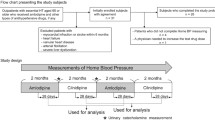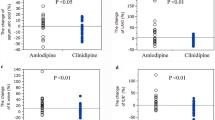Summary
The effect of enalapril alone and in combination with nadolol on resting and exercising blood pressure, heart rate, plasma renin activity, aldosterone, noradrenaline, and potassium levels was studied in 10 hypertensive patients (diastolic blood pressure between 95 and 114 mmHg). Patients received placebo for 4 weeks, enalapril (mean daily dose 24.5 mg) for 8 weeks, and nadolol, 40 mg once daily, was added for the remaining 8 weeks of the study. Exercise testing (modified Bruce, treadmill) was conducted at the end of the placebo run-in phase and at the end of each treatment period. Enalapril reduced resting and exercising blood pressure independent of any change in heart rate: This effect was increased with combination treatment. Plasma renin activity at rest and during exercise was increased by enalapril. Combination treatment attenuated this response and significantly reduced plasma aldosterone. Neither treatment had any effect on plasma noradrenaline levels. Resting plasma potassium levels were increased with combination treatment, whereas both treatment regimens increased plasma potassium levels during exercise. There were no clinically relevant episodes of hyperkalemia. Further investigation is required to qualify the nature of the blood pressure and plasma potassium response with combination treatment.
Similar content being viewed by others
References
Cade R, Mars D, Wagemaker H, et al. Effects of aerobic exercise training on patients with systemic arterial hypertension. Am J Med 1984;77:785–790.
Nelson L, Jennings GL, Esler MD, Korner PI. Effect of changing levels of physical activity on blood pressure and haemodynamics in essential hypertension. Lancet 1986;2: 473–476.
Arakawa K. Non-pharmacological measures for lowering blood pressure. Cardiovasc Drugs Ther 1989;3:847–852.
SCRIP 1990;1537:26.
SCRIP 1990;1540:22.
SCRIP 1990;1572;21.
Ades PA, Gunther PGS, Meacham CP, et al. Hypertension, exercise and beta adrenergic blockade. Ann Intern Med 1989;109:629–634.
Sullivan PA, Daly B, O'Connor R, Dineen M. Effects of atenolol on exercise-induced changes of blood pressure, plasma potassium, plasma renin activity, and plasma aldosterone in essential hypertension. J Hypertens 1986;4(Suppl 5):S498-S500.
Smith M. Catecholamines and plasma potassium. Br J Hosp Med 1988;40:294–299.
Lundborg P. The effect of adrenergic blockade on potassium concentrations in different conditions. Acta Med Scand 1983(Suppl)672:121–126.
Linton RAF, Lim M, Wolff CB, et al. Arterial plasma potassium measured continuously during exercise in man. Clin Sci 1984;67:427–431.
Laustiola K, Uusitalo H, Kolvula T, et al. Divergent effects of atenolol, practolol and propranolol on the peripheral metabolic changes induced by dynamic exercise in healthy man. Eur J Clin Pharmacol 1983;25:293–297.
Sullivan PA, Daly B, O'Neill S, et al. Effects of angiotensin converting enzyme inhibition (enalapril) on exercise-induced changes of blood pressure, heart rate, plasma renin activity and plasma aldosterone. J Hypertens 1986;4(Suppl 5): S429-S431.
Fagard R, Lijnen P, Amary A. Haemodynamic response to captopril at rest and during exercise in hypertensive patients. Am J Cardiol 1982;49:1569–1571.
Sullivan PA, Dineen M, Cerevenka J, O'Connor DT. Effects of fosenopril, a once daily angiotensin converting enzyme inhibitor, on resting and exercise-induced changes of blood pressure, hormonal variables, and plasma potassium in essential hypertension. Am J Hypertens 1988;1:280S-283S.
Pickering TG, Case DB, Sullivan PA, Laragh JH. Comparison of the antihypertensive and hormonal effects of captopril and propranolol at rest and during exercise. Am J Cardiol 1982;49:1566–1568.
Textor SC, Bravo EL, Fouad FM, Tarazi RC. Hyperkalaemia in azotemic patients during angiotensin converting enzyme inhibition and aldosterone reduction with captopril. Am J Med 1982;73:719–725.
Haber E, Koerner T, Page LB, et al. Application of a radioimmunoassay for angiotensin I to the physiologic measurements of plasma renin activity in normal human subjects. J Clin Endocrinol Metab 1969;29:1349–1355.
Peuler JD, Johnson GA. Simultaneous single isotope radioenzymatic assay of plasma norepinephrine, epinephrine and dopamine. Life Sci 1977;21:625–636.
Ades PA. Cardiac effects of beta blockade with intrinsic sympathomimetic activity during submaximal exercise. Br J Clin Pharmacol 1987;24(Suppl 1):29S-33S.
Franciosa JA, Johnson SM, Tobian LJ. Exercise performance in mildly hypertensive patients. Chest 1980;78: 291–299.
McLeod AA, Broan JE, Kuhn C, et al. Differentiation of haemodynamic, humoral and metabolic responses to beta1 and beta2-adrenergic stimulation in man using atenolol and propranolol. Circulation 1983;67:1076–1084.
Nussberger J, Waeber B, Brunner HR. Clinical pharmacology of ACE inhibition. Cardiology 1989;76(Suppl 2):11–22.
Imai Y, Abe K, Seino M, et al. Captopril attenuates pressor responses to norepinephrine and vasopressin through depletion of endogenous angiotensin II. Am J Cardiol 1982; 49:1537–1539.
Phillip T, Aryas M, Hans MT, et al. Sympathetic nervous activity and noradrenaline reactivity during angiotensin converting enzyme inhibition. Am J Cardiol 1982;49:55D-59D.
Weinberger MH. Role of sympathetic nervous system activity in the blood pressure response to long term captopril therapy in severely hypertensive patients. Am J Cardiol 1982;49:1542–1543.
Kohlmann O, Bresnahan M, Gavras H. Central and peripheral indices of sympathetic activity after blood pressure lowering with enalapril (MK 421) or hydralazine in normotensive rats. Hypertension 1984;6(Suppl 1):I1–16.
Author information
Authors and Affiliations
Rights and permissions
About this article
Cite this article
Sullivan, P.A., Daly, B. & O'Connor, R. Enalapril versus combined enalapril and nadolol treatment: Effects on blood pressure, heart rate, humoral variables, and plasma potassium at rest and during exercise in hypertensive patients. Cardiovasc Drug Ther 6, 261–265 (1992). https://doi.org/10.1007/BF00051148
Issue Date:
DOI: https://doi.org/10.1007/BF00051148




